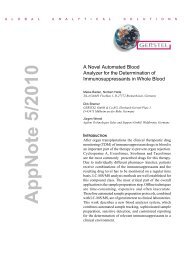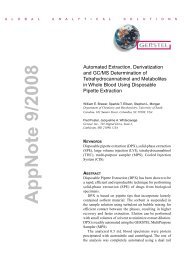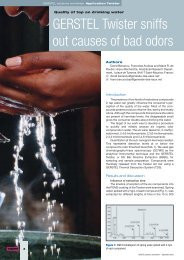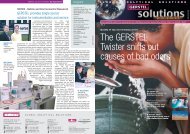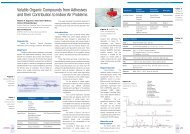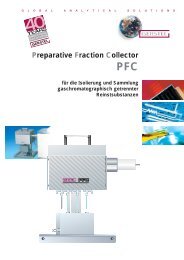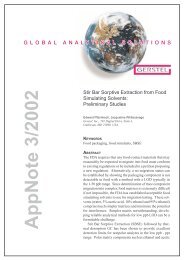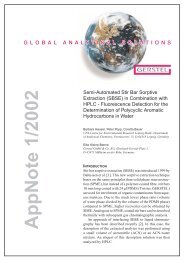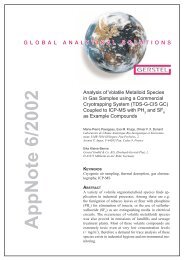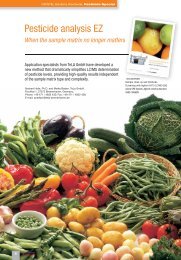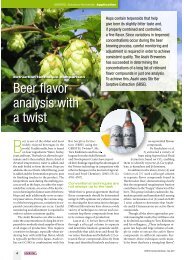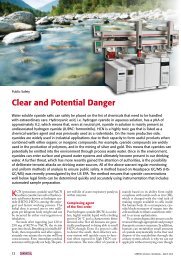Automated DPX process - Gerstel
Automated DPX process - Gerstel
Automated DPX process - Gerstel
Create successful ePaper yourself
Turn your PDF publications into a flip-book with our unique Google optimized e-Paper software.
M<br />
onomers are generally<br />
low molecular weight<br />
compounds with special<br />
functional groups that enable polymerization.<br />
Depending on the structure<br />
and properties of monomers, and<br />
on the conditions chosen, polymerization<br />
can lead to the formation<br />
of linear, branched, or crosslinked<br />
polymers, which have different<br />
chemical and physical properties.<br />
In order to determine the<br />
structure of a polymer, pyrolysis<br />
GC is often used as the technique<br />
of choice; it is a powerful tool in the<br />
characterization of complex polymers<br />
whether they are in solid or liquid form<br />
or in emulsion.<br />
Curie-Point pyrolyzers are widely used<br />
for polymer analysis. Some are based on resistive<br />
heating, some on microwave technology.<br />
Technical aspects aside, the use of<br />
special pyrolyzers can be labor intensive,<br />
sometimes requiring additional cumbersome<br />
sample preparation steps as well as<br />
significant added investment volume. A<br />
different, simpler, and more cost-effective<br />
way has been described by scientists from<br />
GERSTEL Solutions Worldwide Innovation<br />
Polymer analysis<br />
Efficient <strong>Automated</strong> Pyrolysis GC<br />
Scientists from Dow, a leading producer and supplier of chemicals and<br />
polymer products, have collaborated with GERSTEL scientists in developing<br />
a novel method for determining the structure and composition<br />
of polymers. The approach: Following a high-temperature liquid sample<br />
introduction, pyrolysis is performed in the high-temperature version<br />
Cooled Injection System 6 (CIS 6) GC inlet. Pyrolysis break-down products<br />
are subsequently determined using GC/FID or GC/MS.<br />
DOW and GERSTEL who cooperated on<br />
developing an attractive alternative to standard<br />
methods.<br />
“Instead of a dedicated pyrolyzer, we<br />
used the CIS 6, the high-temperature version<br />
of the GERSTEL Cooled Injection<br />
System (CIS)”, says Patric<br />
Eckerle, Dow Germany. The<br />
GERSTEL CIS is the most widely<br />
used PTV-type inlet in the world.<br />
Liquid polymers and polymer<br />
mixtures were pyrolyzed directly<br />
in the GC inlet in an oxygen-free<br />
carrier gas atmosphere. Pyrolysis<br />
break-down products were then<br />
transferred to the GC column,<br />
separated and determined using a Flame<br />
Ionization Detector (FID).<br />
To prove the validity of the method, the<br />
scientists analyzed different polymer mixtures:<br />
1. An emulsion based on a 1:100 styrenebutadiene<br />
polymer mixture diluted<br />
with water was examined in order to<br />
determine recovery rates. In this context,<br />
Eckerle examined the influence of<br />
the GERSTEL CryoTrap System (CTS)<br />
on the quality of the separation.<br />
Improved peak shape: The GERSTEL CryoTrap System (CTS) significantly improved both<br />
separation capacity and accuracy in the determination of volatile pyrolysis fragments by<br />
focusing these and sharpening the peaks.<br />
12<br />
2. A styrene-butadiene polymer mixture<br />
containing varying amounts of emulgated<br />
copolymer (butylacrylate-styrene)<br />
was analyzed in order to verify<br />
the quantitation.<br />
3. Polyethylene (PE), dissolved in hot xylene,<br />
was analyzed using two-dimensional<br />
GC (2D GC and GCxGC).<br />
For the polymer analysis, the experts<br />
used a GC system with a GERSTEL Multi-<br />
Purpose Sampler (MPS), which was used<br />
for automated sample preparation and sample<br />
introduction. The MPS was equipped<br />
with a headspace syringe adapter, a heated<br />
10 µL syringe and a heated agitator. The GC<br />
6890 from Agilent Technologies was fitted<br />
with a GERSTEL CIS 6 programmed temperature<br />
vaporizer as well as an FID.<br />
And this is how Eckerle and his colleagues<br />
approached the task: Following<br />
sample preparation, 0.5 to 2 µL of the dissolved<br />
polymer was introduced into the<br />
cool CIS liner. Solvents were then purged<br />
from the inlet through the split vent, leaving<br />
the polymer material condensed on the<br />
CIS liner walls. The temperature of the CIS<br />
was kept at 90 °C for 3.5 minutes during the<br />
First class results: Repeatability of 10 CIS pyrolysis runs of an S/B<br />
copolymer. The CIS was not cleaned or replaced over the course<br />
of these runs.<br />
GERSTEL Solutions Worldwide – March 2009



